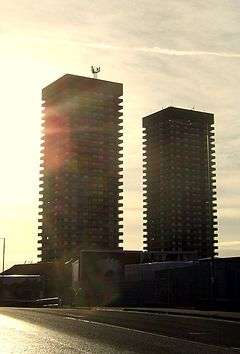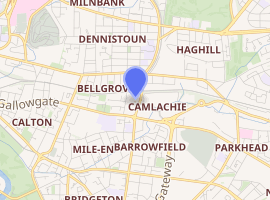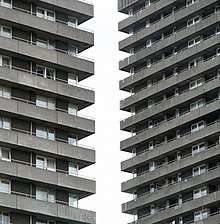Bluevale and Whitevale Towers
The Bluevale and Whitevale Towers was the name for a development of twin tower block flats situated in the Camlachie district within the East End of Glasgow, Scotland. Officially known as 109 Bluevale Street and 51 Whitevale Street (often nicknamed the Gallowgate Twins or the Camlachie Twin Towers), the two towers were the tallest buildings in Scotland[1][2] although with only 29 occupiable floors (the 30th floor was a mechanical floor for building services and a drying area),[3] they were not the buildings with the highest occupied floor level in the city (or Scotland); that distinction belonged to the contemporary Red Road estate on the north side of the city. They were briefly Scotland's second tallest freestanding structure following the demolition of Inverkip Power Station on the Firth of Clyde in 2013.
| 'Bluevale and Whitevale Towers' | |
|---|---|
109 Bluevale Street/51 Whitevale Street | |
 | |

| |
| Alternative names | Bluevale/Whitevale Towers Gallowgate Twins Camlachie Twin Towers |
| General information | |
| Status | Demolished |
| Type | Residential |
| Architectural style | Brutalist |
| Address | 109 Bluevale Street 51 Whitevale Street |
| Town or city | Camlachie, Glasgow |
| Country | Scotland, United Kingdom |
| Construction started | 1967 |
| Completed | 1968 |
| Height | |
| Roof | 90.8 metres (298 ft) |
| Top floor | 30 (29 habitable + 2 mechanical) |
| Technical details | |
| Structural system | Pre-cast Concrete |
| Floor count | 30 |
| Lifts/elevators | 2 |
| Design and construction | |
| Architect | David Harvey Alex Scott & Associates |
After originally being condemned in 2011, in early 2016 the demolition of both towers was completed, meaning that the Glasgow Tower is now the tallest freestanding structure in both Glasgow and Scotland as a whole.
History

Faced with crippling housing shortages in the immediate post-war period, the city undertook the building of multi-storey housing in tower blocks in the 1960s and early 1970s on a grand scale, which led to Glasgow becoming the first truly high-rise city in Britain. However, many of these "schemes", as they are known, were poorly planned, or badly designed and cheaply constructed, which led to many of the blocks becoming insanitary magnets for crime and deprivation.
It would not be until 1988 that high rises were built in the city once again, with the construction of the 17-storey Forum Hotel next to the SECC. The 20-storey Hilton Hotel in Anderston followed in 1992. From the early 1990s, Glasgow City Council and its successor, the Glasgow Housing Association, have run a programme of demolishing the worst of the residential tower blocks, including Basil Spence's Gorbals blocks in 1993.
The buildings were also unique in their construction - featuring hydraulic jacks in their foundations to combat sway due to their height.
Demolition
In November 2011, it was announced by Glasgow Housing Association of the intention to demolish the development,[4] citing the unpopularity of the estate among residents and high maintenance and running costs.
Demolition of the towers was originally scheduled to take place prior to the 2014 Commonwealth Games, but the complexity of the task pushed the date back to early 2015. Owing to the buildings' design, and their close proximity to the busy North Clyde Line railway which runs immediately next to the site, a conventional "blowdown" with explosives was deemed impractical. The buildings instead would be literally disassembled floor by floor using the "top down" method.[5] The deconstruction process began on in January 2015, starting with the Bluevale tower. The neighbouring Whitevale tower was deconstructed in a similar fashion in 2016.[6]
References
- "Britains Tallest 100 Buildings by Height". skyscrapernews.com. Retrieved 8 June 2008.
- http://skyscraperpage.com/diagrams/?searchID=50166628&page=1
- Urban Realm. "Glasgow's tallest towers to be knocked down". Urban Realm. Retrieved 13 December 2011.
- "City to Knock Down Tallest Towers". Glasgow Evening Times. Retrieved 29 November 2011.
- Gale, Lindsay (25 February 2015). "First 'Gallowgate Twin' shrinks". Demolition and Recycling International. KHL. Archived from the original on 12 March 2015.
- "Gallowgate Twins flats brought down using new UK demolition method". Evening Times. 16 December 2015. Retrieved 17 February 2019.
External links
| Wikimedia Commons has media related to Bluevale and Whitevale Towers. |
- 'Lights Out', study of Gallowgate at Disappearing Glasgow